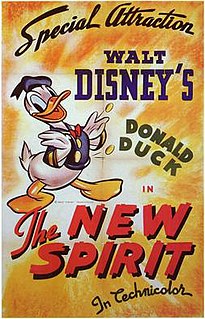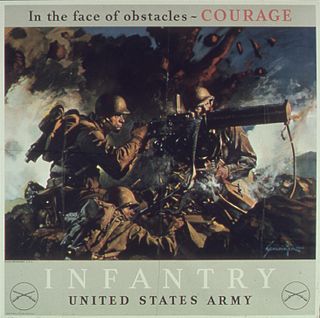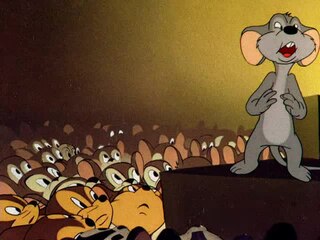
Why We Fight is a series of seven propaganda films produced by the US Department of War from 1942 to 1945, during World War II. It was originally written for American soldiers to help them understand why the United States was involved in the war, but US President Franklin Roosevelt ordered distribution for public viewing.

The Greater East Asia Co-Prosperity Sphere, or the GEACPS, was an imperialist concept which was developed in the Empire of Japan and propagated to Asian populations which were occupied by it from 1931 to 1945. It extended across the Asia-Pacific and promoted the cultural and economic unity of East Asians, Southeast Asians, South Asians and Oceanians. It also declared the intention to create a self-sufficient bloc of Asian nations which would be led by the Japanese and be free from the rule of Western powers. The idea was first announced on 1 August 1940 in a radio address delivered by Foreign Minister Yōsuke Matsuoka.

The United States Office of War Information (OWI) was a United States government agency created during World War II. The OWI operated from June 1942 until September 1945. Through radio broadcasts, newspapers, posters, photographs, films and other forms of media, the OWI was the connection between the battlefront and civilian communities. The office also established several overseas branches, which launched a large-scale information and propaganda campaign abroad. From 1942 to 1945, the OWI revised or discarded any film scripts reviewed by them that portrayed the United States in a negative light, including anti-war material.

The Office of the Coordinator of Inter-American Affairs, later known as the Office for Inter-American Affairs, was a United States agency promoting inter-American cooperation (Pan-Americanism) during the 1940s, especially in commercial and economic areas. It was started in August 1940 as OCCCRBAR with Nelson Rockefeller as its head, appointed by President Franklin Delano Roosevelt.

Prelude to War is the first film of Frank Capra's Why We Fight film series commissioned by the Office of War Information (OWI) and George C. Marshall. It was made to educate American troops of the necessity of combating the Axis powers during World War II based on the idea that those in the service would fight more willingly and ably if they knew the background and the reason for their participation in the war. The film was later released to the general American public as a rallying cry for support of the war.

War Comes to America is the seventh and final film of Frank Capra's Why We Fight World War II propaganda film series.

The New Spirit is a 1942 American animated short film produced by Walt Disney Productions and the U.S. Department of the Treasury, and released by the War Activities Committee of the Motion Pictures Industry. The cartoon, which stars Donald Duck, was the first film created as part of Walt Disney's World War II propaganda production. It was commissioned by Henry Morgenthau Jr., then Secretary of the Treasury, to encourage American citizens to pay their income tax in support of the war effort. The film was directed by Wilfred Jackson and Ben Sharpsteen, and features Clarence Nash as the voice of Donald, Fred Shields as the radio announcer, and Cliff Edwards singing the theme song.
December 7th is a 1943 propaganda documentary film produced by the US Navy and directed by John Ford and Gregg Toland, about the December 7, 1941 attack on Pearl Harbor, the event which sparked the Pacific War and American involvement in World War II. Toland was also the film's cinematographer. The original version of this film, with a running time of 82 minutes, was not released but was retained by the National Archives. An edited version of 32 minutes length, which removed a long introductory segment and a shorter epilogue, was given limited release to specific audiences but won the Academy Award for Best Documentary in 1944.

Ring of Steel is a 1942 short documentary film directed by Garson Kanin and narrated by Spencer Tracy. "Dedicated to the American Soldier", the film was released on April 2, 1942, and distributed free to all U.S. theaters. The film was produced by Warner Bros. and the United States Office for Emergency Management.
The Town is a short propaganda film produced by the Office of War Information in 1943. The documentary, depicting the American Midwestern city of Madison, Indiana was filmed by Josef von Sternberg in 1943 and released in 1945.

During active American involvement in World War II (1941–45), propaganda was used to increase support for the war and commitment to an Allied victory. Using a vast array of media, propagandists instigated hatred for the enemy and support for America's allies, urged greater public effort for war production and victory gardens, persuaded people to save some of their material so that more material could be used for the war effort, and sold war bonds. Patriotism became the central theme of advertising throughout the war, as large scale campaigns were launched to sell war bonds, promote efficiency in factories, reduce ugly rumors, and maintain civilian morale. The war consolidated the advertising industry's role in American society, deflecting earlier criticism. The axis leaders were portrayed as cartoon caricatures to make them appear foolish and idiotic.

Women in Defense is a 1941 short film produced by the Office of Emergency Management shortly before the United States entered the Second World War. It was directed by John Ford.

Britain re-created the World War I Ministry of Information for the duration of World War II to generate propaganda to influence the population towards support for the war effort. A wide range of media was employed aimed at local and overseas audiences. Traditional forms such as newspapers and posters were joined by new media including cinema (film), newsreels and radio. A wide range of themes were addressed, fostering hostility to the enemy, support for allies, and specific pro war projects such as conserving metal and growing vegetables.
Tuesday in November was a propaganda short about the 1944 United States presidential election produced by the Office of War information for overseas distribution. It is meant to explain how the democratic process in America works.
Two Down and One to Go was a short propaganda film produced in 1945 directed by Frank Capra; as its title might suggest, its overall message was that the first two Axis powers, Italy and Germany, had been defeated, but that one, Japan, still had to be dealt with.

The Fifth-Column Mouse is a 1943 Warner Bros. Merrie Melodies animated cartoon directed by Friz Freleng. The short was released on March 6, 1943.

During World War II, a number of significant economic, political, and military changes took place in Latin America. The war caused considerable panic in the region over economics as a large portions of economy of the region depended on the European investment capital, which was shut down. Latin America tried to stay neutral at first but the warring countries were endangering their neutrality. In order to better protect the Panama Canal, combat Axis influence, and optimize the production of goods for the war effort, the United States through Lend-Lease and similar programs greatly expanded its interests in Latin America, resulting in large-scale modernization and a major economic boost for the countries that participated.
Food Will Win the War is an American short animated film produced by Walt Disney Studios and released on July 21, 1942, seven months and two weeks after the December 7, 1941 attack on Pearl Harbor. The 6-minute short was one of a series of animated films produced by Disney during the war as part of a propaganda campaign. The animation was produced on order of the Department of Agriculture, first and foremost to educate about the importance of American agriculture in the war effort and also, to offset fears and panic of Americans who thought too many supplies were being sent overseas. The film was a morale boosting production, in the hope of improving public mood and opinion about sacrifice for the war effort.
Propaganda in World War II had the goals of influencing morale, indoctrinating soldiers and military personnel, and influencing civilians of enemy countries.












